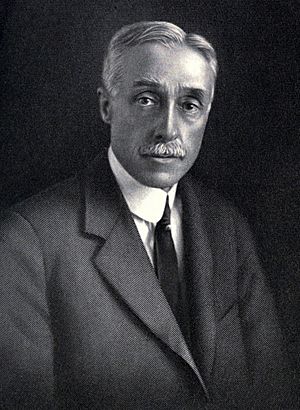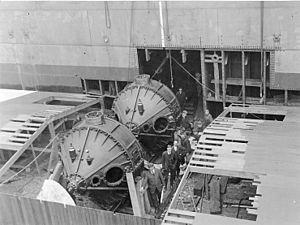Elmer Ambrose Sperry facts for kids
Quick facts for kids
Elmer Ambrose Sperry Sr.
|
|
|---|---|
 |
|
| Born | October 12, 1860 |
| Died | June 16, 1930 (aged 69) |
| Nationality | American |
| Education | Cornell University |
| Known for | gyroscopic compasses |
| Spouse(s) | Zula Augusta Goodman (1860–1929) (m. 1887–1929) |
| Children | Helen M. Sperry (1889–Oct 1977) Edward Goodman Sperry (1890–1945) Lawrence Burst Sperry (1892–1923) Elmer Ambrose Sperry, Jr. (1894–1968) |
| Parent(s) | Stephen Decatur Sperry (1825–1889) Mary Burst (1839–1860) |
| Awards | John Fritz Medal (1927) Elliott Cresson Medal (1929) |
| Signature | |
 |
|
Elmer Ambrose Sperry Sr. (born October 12, 1860 – died June 16, 1930) was a brilliant American inventor and businessman. He is best known for creating the gyrocompass and for starting the Sperry Gyroscope Company. People called him the "father of modern navigation technology."
Sperry's special compasses and ship stabilizers were used by the United States Navy. They were very important during both World War I and World War II. He also worked closely with companies and the government in Japan. After he died, a book of memories was published in Japan to honor him.
Contents
Early life
Elmer Sperry was born in Cincinnatus, New York, on October 12, 1860. His mother, Mary Burst, sadly died the day after he was born. His family had lived in the Northeastern United States since the 1600s. They were of English ancestry.
Sperry studied at the State Normal School in Cortland, New York, for three years. Then, he spent a year at Cornell University from 1878 to 1879. There, he became very interested in dynamos, which are machines that make electricity.
In early 1880, he moved to Chicago, Illinois. Soon after, he started his first company, the Sperry Electric Company. On June 28, 1887, he married Zula Augusta Goodman in Chicago.
Career
Early inventions
In 1887, Sperry developed a clever system to bring electricity into coal mines. He heated the copper wires to stop them from rusting. This allowed him to use his own mining equipment deep underground. His invention greatly helped increase coal production. In 1888, the Sperry Electric Machinery Mining Company was founded.
By 1890, Sperry started the Sperry Electric Railway Company. He used ideas from his electric mining trains to create electric trolleys. These trolleys were used in big, hilly cities in Ohio and Pennsylvania. While working on this company, Sperry also designed an electric automobile. He patented ideas that were later used in portable lead-acid batteries. In 1896, he drove his car in Paris, France. It was the first American-made car to be driven there. In 1894, General Electric bought his railway company and all its patents.
In 1900, Sperry set up a special lab in Washington, D.C.. Here, he and his partner, Clifton P. Townshend, found a way to make pure caustic soda. They also discovered a method to get tin back from scrap metal.
Work with gyroscopes
After feeling seasick on a trip across the Atlantic Ocean in 1898, Sperry started working on a solution. He wanted to put a large gyroscope inside a ship to make it more stable in rough waves. His ship stabilizer was special because it had a sensor. This sensor could detect the first signs of a wave. This allowed the system to react quickly and reduce the ship's rocking motion.
In 1911, Sperry worked with the US Navy to put his gyroscopic stabilizer on Navy ships. It greatly reduced how much a ship would roll. Even though it worked well, Sperry's gyrostabilizer was not sold widely. This was because it was very expensive to install and maintain.
Sperry found another important use for his gyroscopes in 1908. At that time, magnetic compasses on large steel battleships had problems. The metal of the ship would interfere with the Earth's magnetic field. This made it hard for the compasses to point to magnetic north. Working with Hannibal C. Ford, Sperry began to develop a gyrocompass to replace the magnetic compass.
In 1910, he founded the Sperry Gyroscope Company in Brooklyn, New York. This company was based on his new gyrocompass. His first navigation gyroscope was tested that same year on the USS Delaware (BB-28). After successful tests, Sperry's gyrocompass was installed on American, British, French, Italian, and Russian naval ships. During World War I, the gyrocompass became even more important. It was adapted to automatically control a ship's steering, helping it stay on a steady course.
Aircraft improvements
In 1913, Sperry and his son Lawrence Burst Sperry created a gyro that could control parts of an aircraft. This gyro could move the elevators and ailerons using special motors called servos. Sperry successfully put his gyrostabilizer technology, which was thought to be only for large ships, into aircraft.
In June 1914, Sperry and his son won a competition held by the Aéro-Club de France. They showed how their stabilizer made aircraft safer. His son even flew the plane "no-hands" past the judges! Sperry also received a Franklin Institute Medal that year. This gyrostabilization system was not widely used at the time. However, it created the basic ideas for his son's autopilot system.
In 1916, Sperry worked with Peter Hewitt to create the Hewitt-Sperry Automatic Airplane. This was one of the first successful aircraft that could fly without a pilot, like today's drones.
In 1917, Sperry solved a problem with aircraft compasses. When a plane turned, magnetic compasses would often show the wrong direction. Sperry invented the Gyro Turn Indicator to fix this. This indicator was later improved into what is now called the Turn and Slip Indicator. With a Directional Gyro and Gyro Horizon added later, Sperry created a set of flight instruments. These became standard equipment on all aircraft.
During both World War I and World War II, Sperry's company made a lot of money. This was because of the military's high demand for gyroscopes. His technology was used in torpedoes, ships, airplanes, and even spacecraft. Sperry also developed related devices. These included bombsights, fire control systems, radar, and systems for automated take-off and landing. During World War I, he worked on a "flying bomb." On March 6, 1918, he successfully guided an aerial torpedo for more than half a mile using radio control.
Working with the US Navy, Sperry developed a system to control all the guns on a battleship from inside the ship. This control system used his gyroscopic equipment. It could correct the position of each gun based on how the ship was moving. This allowed all the guns to aim at the same target. This control system was installed on all United States Navy battleships during World War I.
Sperry was also a founding member of the U.S. Naval Consulting Board in 1915. This board advised the Navy on new technologies.
Starting in 1914, Sperry began working with the US Navy to create brighter lights for naval gun turrets. From this partnership, Sperry and his team created a new type of arc lamp. This lamp heated a gas to make it glow. It produced light that was five times brighter than other continuous light sources at the time. In 1918, he made a high-intensity arc lamp. Both the Army and Navy used it as a searchlight.
Later life and death
In 1923, Sperry's son Lawrence died in the English Channel. He was in a plane crash involving an aircraft he had designed himself. In January 1929, Sperry sold his Sperry Gyroscope Company to North American Aviation. The next year, on March 31, his wife died in Havana, Cuba.
Elmer Sperry died at St. John Hospital in Brooklyn, New York, on June 16, 1930. He was 69 years old. He passed away from problems after surgery to remove gallstones six weeks earlier.
Awards
Elmer Sperry received many awards for his amazing inventions:
- Aéro-Club de France (1914) for his airplane stabilizer.
- Franklin Institute Medal (1914) for his gyroscopic compass.
- Collier Trophy (1914) for gyroscopic control.
- Collier Trophy (1916) for his drift indicator.
- Holley Medal (1928).
- John Fritz Medal (1927).
- Albert Gary Medal (1927).
- Elliott Cresson Medal (1929) for his gyroscopic navigation and recording tools.
- Two awards from the last Czar of Russia.
- Two awards from the Emperor of Japan: the Order of the Rising Sun and the Order of the Sacred Treasure.
- The grand prize of the Panama Exposition.
- He was honored in the National Aviation Hall of Fame in 1973.
Companies
Elmer Sperry founded or was involved with several important companies:
- Sperry Electric Mining Machine Company (1888)
- Sperry Electric Railway Company (1894)
- Chicago Fuse Wire Company (1900)
- Sperry Rail Service (1911), a company that finds defects in train tracks.
- Sperry Gyroscope Company (1910), founded to make Sperry's improved gyrocompass. The first model was installed on the battleship USS Delaware in 1911.
Legacy
Elmer Sperry's work continues to be remembered:
- The Elmer A. Sperry Award is named after him. This award encourages new ideas in transportation engineering.
- The USS Sperry (AS-12), a special ship that helps submarines, was named in his honor.
- The Sperry Center at SUNY Cortland in Cortland, New York, is named after him.
Images for kids
See also
 In Spanish: Elmer Ambrose Sperry para niños
In Spanish: Elmer Ambrose Sperry para niños




